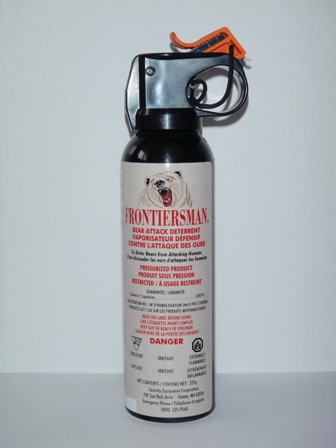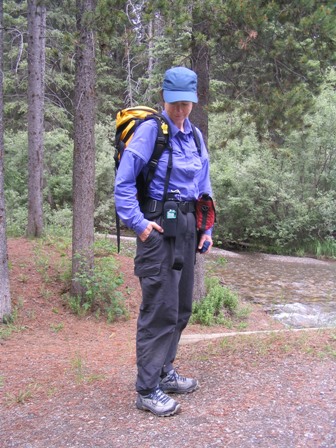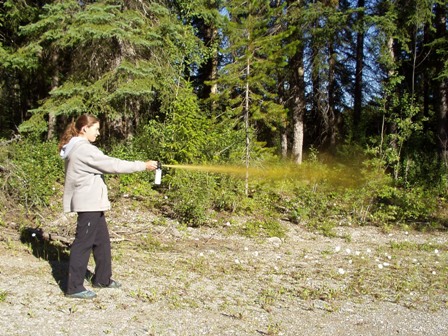
Bear spray
Bears in the mountain national parks
Whether you are hiking, picnicking, camping, biking, trail running, or paddling in Parks Canada’s Mountain Parks, carrying bear spray is a good idea. It may reduce your risk of injury if you are in an aggressive encounter with a bear and/or other aggressive wildlife. Using bear spray is always a last resort; do all you can to avoid a bear encounter in the first place. Prepare carefully before you head into bear country.
1. What is bear spray?
It is a deterrent containing capsaicin, a chemical found in chili peppers. It comes in a small, portable spray canister and is intended to repel a bear in the event of a close encounter.

2. What does it do?
The canister releases a cone-shaped cloud of pepper spray to a distance of approximately 10 m and at a speed of over 100 km/h. When a bear walks into the spray, its eyes and skin will sting and it will have difficulty breathing—symptoms nasty enough to prompt a retreat. The spray is non-lethal: the bear will be uncomfortable, but unharmed.
3. What should I look for when buying bear spray?
- Check the expiry date.
- Does it have a safety clip?
- Does it say bear spray or bear repellent? To be legal in Canada, the label must clearly show that it is intended for use on animals; the package volume cannot exceed 500 ml.
- Size and strength: a 225 ml can (about 10 seconds worth) with 0.75%-1% capsaicin is recommended.
4. Before hitting the trail
- Read the instructions.
- Carry it in a holster you can easily reach with your dominant hand (if you are right-handed, carry it on the right side of your body). If you are biking, place it in the bike’s water bottle rack. Having it in your pack is a no-no—a surprise bear encounter can happen in seconds, and you want to be ready!
- Practice—spray a short burst outdoors to make sure the can is working properly and to become familiar with the spray radius and your reaction time. Practice reaching for your spray and undoing the safety clip several times. Stores will sometimes have inert cans you can use to get the hang of it.
- At least one person in your group should carry it, but it’s best if everyone has their own (you want backup, right?).

5. Getting there
En route to the trail, carry it with the safety clip on in the trunk of your vehicle or in a sealed container. Avoid temperature extremes and the risk of puncturing. It is not permissible to carry bear spray on a commercial airline, even in your checked baggage.
6. When should I use it?
Bear spray is your “last-resort” tool: have it ready, but try to calmly and slowly get out of the bear’s way first. If the bear comes towards you, yell “Hey Bear!” The bear has to be in close range (less than a bus length) for your spray to be effective. Use only if the bear acts aggressively.
7. How do I use it?
Remove the safety clip and aim for the bear’s face (make sure the nozzle is pointing away from you). You want to create a wall of spray between you and the bear. Give quick, one-second bursts until the bear retreats. Leave the area immediately. Wind or rain may reduce the spray’s effectiveness; be careful not to get in the path of the spray.

8. How NOT to use it
Don’t spray it on yourself, your tent or your gear. Studies have found that the lingering smell actually attracts bears! If it can stop a bear in its tracks, imagine what it would feel like on you. Check the label for health precautions.
How do I use bear spray?
Transcript
[TEXT TITLE] How do I use bear spray?
Anytime you're in bear country, you should have bear spray with you Whether you're trail running, biking or hiking...
whether it's a short hour long hike or a multi-day backpacking hike, you should always have it readily available.
[Text] Dan Rafla - Resource Management Officer - Banff National Park Don't have it in your backpack, or have it on your belt or on the loop of you backpack.
If you're mountain biking, you could put it in your water bottle holder.
Two really important things to look at is the expiry date. If they are expired or close to expiring, do not use them.
Make sure that it does say, "Bear repellant" or "deterrent" It doesn't repel the bear if we spray it on our clothing or tent; it will attract the bear.
You only use it if a bear is approaching you and at close distance.
Make sure also that the wind is in the right direction.
If a strong wind is blowing in your eyes, chances are, the bear spray will work on you.
In the event that the bear is getting very close, you want to make sure your bear spray is out.
The effective range is five metres. Let it know of you presence.
"Hey Bear! Hey Bear" Flip off the safety and simply press the trigger.
And give short little bursts. Two seconds. Directly in the face of the bear.
It's very effective. In, I think, over 90 per cent of the cases, the bear spray has deterred an attack.
More effective than any other deterrent.
So there you go!
[TEXT] After a bear encounter, leave the area as calmly as possible.
[TEXT] Please report all bear, cougar and wolf encounters and sightings to: Banff National Park Dispatch 403-762-1470
- Date modified :